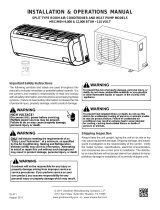
2
MCC-SVN01A-EN© American Standard Inc. 2000
General Information
General Information
This Installation Manual is given as a
guide to good practice in the
installation by the installer of MCC
mini-split system. Installation
procedures should be performed in
the sequence that they appear in this
manual.
For installing the unit to operate
properly and reliably, it must be
installed in accordance with these
instructions. Also, the services of a
qualified service technician should be
employed, through the maintenance
contract with a reputable service
company.
Read this Installation Manual
completely before installing the
air conditioning system.
About this Manual
Cautions appear at appropriate
places in this Installation Manual.
Your personal safety and the proper
operation of this machine require that
you follow them carefully.
The Trane Company assumes no
liability for installations or servicing
performed by unqualified personnel.
All phases of the installation of this air
conditioning system must conform to
all national, provincial, state and local
codes.
About the Unit
These MCC units are assembled,
pressure tested, dehydrated, charged
and run tested before shipment. The
information contained in this manual
applies to MCC units are designed to
operate in cooling mode only.
Trane MCC series offer ceiling
mounted installation to leave the floor
space uncluttered, and equipped with
LCD wireless remote control.
Reception
On arrival, inspect the unit before
signing the delivery note. Specify any
damage of the unit on the delivery
note, and send a registered letter of
protest to the last carrier of the goods
within 72 hours of delivery. Notify the
dealer at the same time.
The unit should be totally inspected
within 7 days of delivery. If any
concealed damage is discovered,
send a registered letter of protest to
the carrier within 7 days of delivery
and notify the dealer.
Warning
Warnings are provided at appropriate
places in this manual to indicate to
installers, operators and service
personnel of potentially hazardous
situations which, if not avoided,
COULD result in death or serious
injury.
Caution
Cautions are provided at appropriate
places in this manual to indicate to
installers, operators, and service
personnel of potentially hazardous
situations which, if not avoided, MAY
result in minor or moderate injury or
malfunction of the unit.
Your personal safety and the proper
operation of this unit require that you
follow them carefully. The Trane
Company assumes no liability for
installations or servicing performed by
unqualified personnel.
Warranty
Warranty is based on the general
terms and conditions by country. The
warranty is void if the equipment is
modified or repaired without the
written approval of The Trane
Company, if the operating limits are
exceeded or if the control system or
the electrical wiring is modified.
Damage due to inappropriate
installation, lack of knowledge or
failure to comply with the
manufacturer’s instructions, is not
covered by the warranty obligation.
If the installation does not conform to
the rules described in Installation
Manual, it may entail cancellation of
warranty and liabilities by The Trane
Company.
Important
This document is customer property
and is to remain with unit. Please
place in service information pack upon
completion of work.
These instructions do not cover all
variations in systems, nor do they
provide for every possible contingency
to be met in connection with
installation.
Should further information be desired
or should particular problems arise
which are not covered sufficiently in
this manual, the matter should be
referred to your authorized Trane
dealer.












